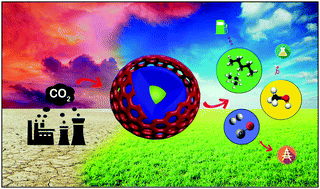Core–shell structured catalysts for thermocatalytic, photocatalytic, and electrocatalytic conversion of CO2
Abstract
Catalytic conversion of CO2 to produce fuels and chemicals is attractive in prospect because it provides an alternative to fossil feedstocks and the benefit of converting and cycling the greenhouse gas CO2 on a large scale. In today's technology, CO2 is converted into hydrocarbon fuels in Fischer–Tropsch synthesis via the water gas shift reaction, but processes for direct conversion of CO2 to fuels and chemicals such as methane, methanol, and C2+ hydrocarbons or syngas are still far from large-scale applications because of processing challenges that may be best addressed by the discovery of improved catalysts—those with enhanced activity, selectivity, and stability. Core–shell structured catalysts are a relatively new class of nanomaterials that allow a controlled integration of the functions of complementary materials with optimised compositions and morphologies. For CO2 conversion, core–shell catalysts can provide distinctive advantages by addressing challenges such as catalyst sintering and activity loss in CO2 reforming processes, insufficient product selectivity in thermocatalytic CO2 hydrogenation, and low efficiency and selectivity in photocatalytic and electrocatalytic CO2 hydrogenation. In the preceding decade, substantial progress has been made in the synthesis, characterization, and evaluation of core–shell catalysts for such potential applications. Nonetheless, challenges remain in the discovery of inexpensive, robust, regenerable catalysts in this class. This review provides an in-depth assessment of these materials for the thermocatalytic, photocatalytic, and electrocatalytic conversion of CO2 into synthesis gas and valuable hydrocarbons.



 Please wait while we load your content...
Please wait while we load your content...